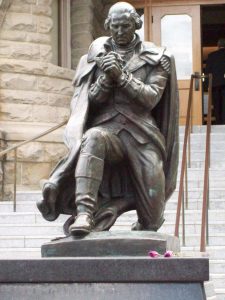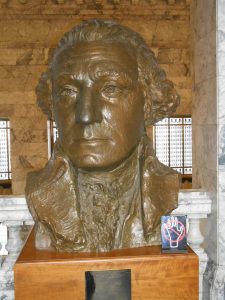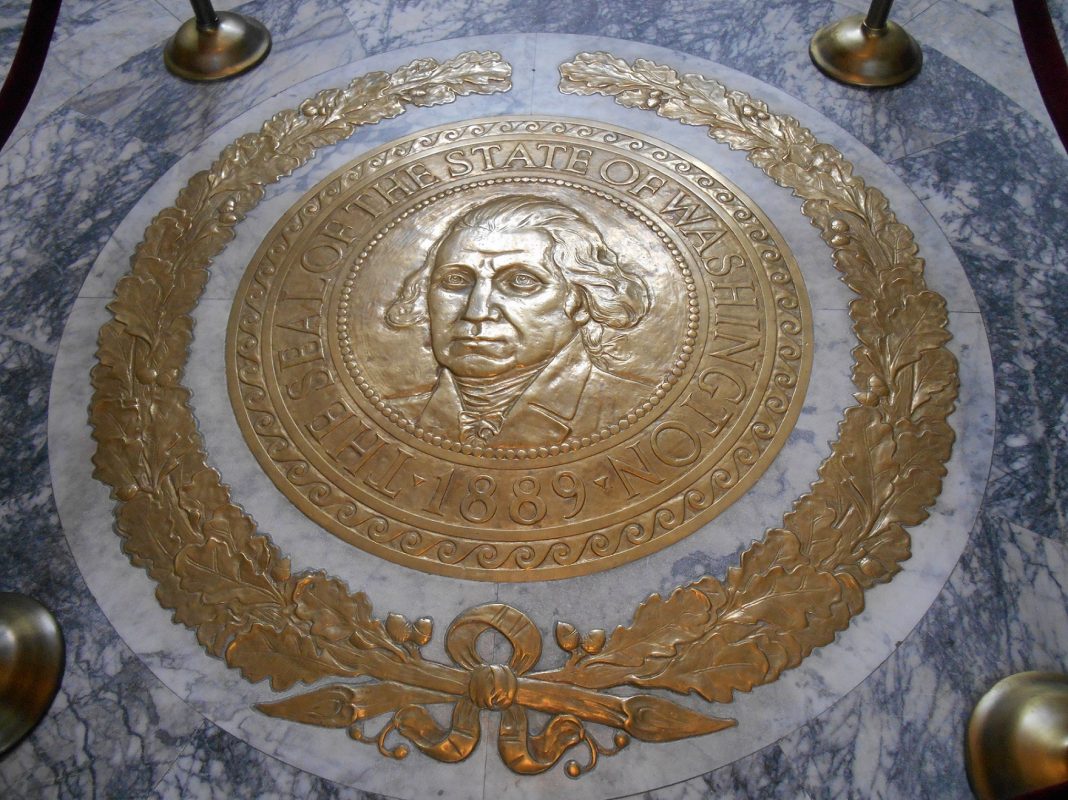George Washington, whose birthday is February 22, is a symbol seen everywhere on the Washington State Capitol campus. Washington is the only American state named after a president. That almost did not happen.
Very few Europeans or Americans had even seen the Pacific Northwest during George Washington’s time and he had no direct connections to the area, though he had been a major supporter of westward expansion for the new country.
The region was claimed by Great Britain, but was coveted by the United States. In 1788, Captain Robert Gray “discovered” the Columbia River. His voyage along the coast helped strengthen America’s later claim to the area. He sailed on the Lady Washington (named for George Washington’s wife Martha). A replica of this ship is a frequent visitor to Olympia’s Harbor Days and can be seen in several movies and television shows, including “Star Trek Generations,” “Pirates of the Caribbean,” “Once Upon a Time,” and was recently featured in “Burn the Ships,” a music video by For King and Country.
American settlers began pouring into the Pacific Northwest in the 1840s. The area became part of the United States in 1846. The Oregon Territory was created two years later, but residents north of the Columbia wanted their own territory. In 1852, delegates met at the Monticello Convention, to write a petition to Congress to create a new territory. They called this potential territory Columbia. The state’s first newspaper, published in Olympia beginning 1852, was even called the Columbian.

Congress approved the convention’s petition with one major modification. They changed the territory’s name to Washington, to honor first president George Washington. Why the change? Congress members felt that the name Columbia would become confused with the District of Columbia, home to the national capital. Ironically, the area has become commonly known as “Washington” leading to confusion between the state and national capital.
Residents of the new territory were surprised, but accepted the new name. The Columbian newspaper quickly changed its name to the Washington Pioneer. Washington became a territory in 1853.
When Washington became a state in 1889, it needed a seal. At first, the legislature design committee considered a seal showing the Port of Tacoma, wheat fields, sheep grazing and Mount Rainier. Olympia jeweler Charles Talcott thought the design too complicated and would become quickly dated. He used an ink bottle to draw a circle, using a silver dollar to form the inner circle. Between the circles he wrote “The Seal of the State of Washington, 1889” and pasted a postage stamp of Washington in center. After the seal was accepted, the Talcotts made a die of it for official use. Charles’s brother George used a color drawing of Washington from a packing box of Dr. D. Jayne’s Cure for Coughs & Colds. George cut the die and Grant, another brother, did the lettering. It was accepted by the State Legislature.
Over two dozen variations of the Washington state seal design were used until 1967 when Seattle graphic designer Richard Nelms redesigned it to resemble a Gilbert Stuart portrait of Washington. The old original die and press are on display at the Secretary of State’s office in the Legislative Building.

A bronze version of state seal is on the floor in the center of the Legislative Building’s rotunda. Very easy to step on, it has been roped off in modern times. In 1923, the state adopted the current flag, the state seal on a field of green. The image of Washington had been used on unofficial state flags since around the turn of the century.
Over time, various groups have found ways to honor George Washington on the State Capitol Campus. The governor’s mansion, built in 1908, was designed in Georgian style to look like it had been built during George Washington’s time. And in 1932, Olympia’s Sacajawea Chapter of the Daughters of the American Revolution sponsored the planting of a seedling of the Washington elm tree for the bicentennial of his birth.
In 1984, the Mother Joseph Foundation donated a bust of George Washington sculpted by Avard Fairbanks. The statue sits on the second floor of the Legislative building. Countless visitors enjoyed rubbing the bust’s nose (traditionally considered good luck) and in 2016 the statue was cleaned, repatinated and sealed in wax, repairing damage done to its nose by countless visitors. Touching the nose is now strictly prohibited.
In 1987, Washington Freemasons donated a replica cast of the Washington at Prayer statue. The original, sculpted by Donald DeLue, was donated by Pennsylvania Freemasons to the Freedoms Foundation’s Medal of Honor Grove at Valley Forge, Pennsylvania in 1967 (George Washington was a member of the Freemasons). The replica statue in Olympia sits in front of the Superintendent of Public Instruction Building (commonly known as the Old State Capitol) across from Sylvester Park. George Washington remains an important figure in our state. His image, seen on every state flag, is a familiar one. He is commemorated all over the Washington State Capitol Campus. Although opinions about George Washington have become more nuanced in recent years, he remains a fascinating person to study. So this year, enjoy a slice of cherry pie for Washington’s Birthday, even if the story of him chopping down a cherry tree is a legend.





















































